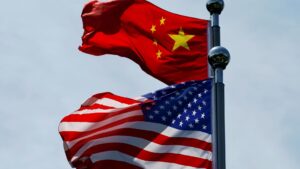Understanding the Rare Earth Minerals Crisis: What It Means for Investors
In the rollercoaster world of global finance, few elements hold as much potential yet remain as precarious as rare earth minerals. With a spotlight currently on U.S.-China tensions, particularly surrounding exports, it’s crucial for investors to grasp how these developments could affect various industries—and their portfolios.
The Background on Rare Earths
Rare earth elements (REE) are critical to a variety of high-tech applications, from electric vehicles and smartphones to advanced military weaponry. China has emerged as the uncontested leader in the mining and production of these strategic minerals, accounting for over 60% of the world’s supply. Recently, the Chinese government announced new export controls targeting seven rare earth elements, leading to widespread concern across multiple sectors.
The U.S.-China Dialogue: A Temporary Truce?
On a recent call between U.S. President Joe Biden and Chinese President Xi Jinping, both leaders acknowledged the pressing nature of current trade imbalances but failed to offer tangible solutions concerning rare earth exports. This ongoing tension raises questions about the stability of supply lines, especially as American companies report dwindling reserves. According to a survey by the American Chamber of Commerce in China, 75% of businesses affected by these controls will exhaust their existing rare earth supplies within three months.
Implications for Industries Beyond Tech
While the tech sector is often highlighted, industries such as automotive and manufacturing are facing immediate disruptions. European auto parts manufacturers, for example, have already halted production due to Chinese export restrictions.
This ripple effect is not isolated to U.S. firms; it extends internationally. The European Union Chamber of Commerce in China recently reported that only about 25% of export license applications are being approved by Chinese authorities. Without timely access to these critical materials, manufacturing operations are grinding to a halt, illustrating the interconnected nature of our global supply chains.
Strategic Movements: The Future of Rare Earth Supplies
Amid anxiety about supply disruptions, some analysts speculate that trade negotiations could lead to a temporary easing of export controls, particularly as China looks to secure the economic standing its rare earths provide. Observers like Jianwei Xu, a senior economist at Natixis, suggest that both nations may focus on non-tariff issues—specifically related to technology and rare earth elements—in upcoming discussions.
What Investors Should Watch For
For stakeholders in the finance sector, understanding these dynamics is essential. Here are several factors to keep in mind:
-
Diversification of Supply Sources: With increasing restrictions on Chinese exports, investors should monitor companies that are actively seeking alternative sources of rare earth minerals. Mines outside China, such as those in Australia and North America, represent a growing segment of the supply chain.
-
Technological Innovations: Companies developing technologies to recycle rare earth elements or create substitutes could emerge as key players in mitigating supply risks.
- Policy Developments: Keep an eye on government interventions. Long-term technology and defense policies in both the U.S. and Asian markets may reshape the landscape, potentially opening up new opportunities for investment.
Conclusion
As the situation surrounding rare earth minerals continues to evolve, the intersection of geopolitics and finance will play a crucial role in determining market directions and investment strategies. For investors, gaining insights into the complexities of this vital sector can illuminate opportunities for profit amid uncertainty.
Stay engaged with us at Extreme Investor Network for more in-depth analysis and expert commentary on the changes shaping our financial landscape. It’s not just about understanding numbers; it’s about grasping the shifting sands of global trade and how they impact your investment choices.

